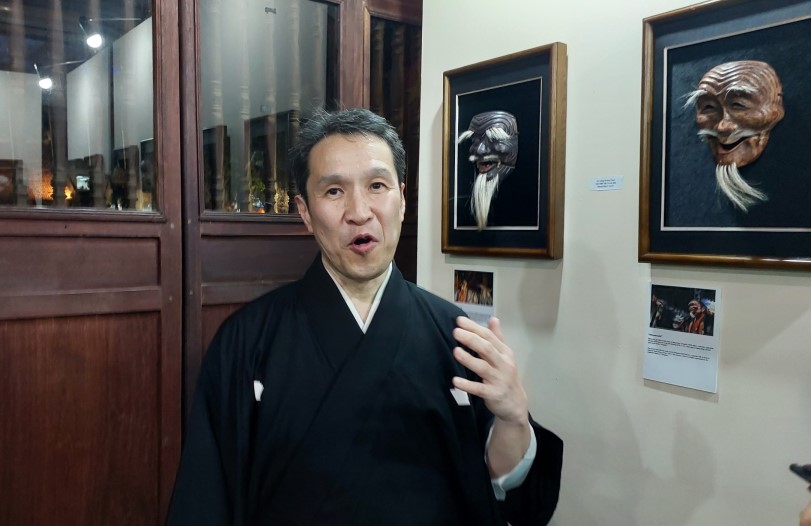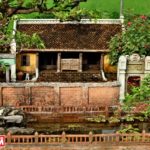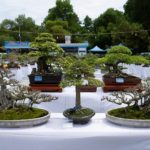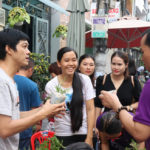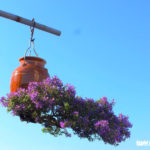The “World of Kyogen Comedy” program will introduce the 650-year-old comic theater of Japan, which was recognized by UNESCO as a World Intangible Cultural Heritage in 2002.
Kyogen is a long-standing traditional art form that the Japanese are proud to introduce to international friends.
The program consists of 2 parts: an introduction to traditional Kyogen comedy and the play “Bonsan”, performed by the artists Ogasawara Tadashi and Ogasawara Hiroaki, father and son. The play heralded the popularity of the bonsai hobby.
| Artist Ogasawara Tadashi introduces Kyogen before the performance. Photo: Ngo Minh/The Hanoi Times |
Artist Ogasawara Tadashi said he was honored to perform Kyogen for Vietnamese audiences on the occasion of the 50th anniversary of the establishment of diplomatic relations between Vietnam and Japan.
“Kyogen is an art form of imagination. The stage of Kyogen has no bulky props or complicated details. I chose the play about bonsai, a theme close to the Vietnamese people. I also learned some Vietnamese words. Therefore, the audience can overcome the language barrier, feel the charm of Kyogen and have a good laugh,” the artist said.
The artist came to Vietnam in 2022 and had the opportunity to learn about life in Vietnam and realized many similarities in the culture and art of the two peoples.
| Ogasawara Hiroaki performs on the stage. Photo: HAUFO |
On this occasion, he also brought 20 masks that he had made himself for the performance of Nohgaku. Nohgaku is the name of traditional Japanese theater art, which includes Noh and Kyogen plays. These works were displayed at the Temple of Literature-Quoc Tu Giam during the “World of Kyogen Comedy” event.
Kyogen, a sort of farce, is commonly referred to as human comedy because it often deals with people and life. Noh, on the other hand, is a tragedy about gods and spirits, typically performed for aristocratic audiences. While Noh is primarily organized by music and dance, Kyogen is a dialogic drama with an emphasis on speech and is therefore referred to as musical theater. While the language of Noh is highly literary, the dialogue of Kyogen is derived from the everyday spoken language of the Muromachi period (1336-1573).
Speaking at the event, Japanese Ambassador to Vietnam Yamada Takio said that Japanese and Vietnamese people have a similarity in loving humor, so this program will bring laughter to Vietnamese audiences and Japanese people living in the capital.
| Nohgaku masks created by artist Ogasawara Tadashi displayed at Temple of Literature. |
“Through the Kyogen comedy show at the Temple of Literature, a symbol of the capital Hanoi and Vietnam, I hope the audience can feel the bonds between Vietnamese-Japanese culture,” the ambassador said.
Le Xuan Kieu, director of the Van Mieu-Quoc Tu Giam Center for Cultural and Scientific Activities, said this is the venue for many important diplomatic and cultural events in Vietnam-Japan relations, such as the visit of the Emperor and Empress of Japan in 2017, the calligraphy performance of artist Takeda Souun in 2013.
“Kyogen’s performance at the Special National Relics of Van Mieu-Quoc Tu Giam can be likened to a meeting of the heritage of the two countries. I hope this interesting and meaningful performance will contribute to promoting mutual understanding between two people,” said Le Xuan Kieu.
Vietnam artisan dedicates life to upside-down bonsai
At the age of 58, Le Thanh from Tam Ky City, located in Vietnam’s Quang Nam Province, has earned a reputation among gardeners as a master of bonsai for creating hundreds of upside-down potted plants.

